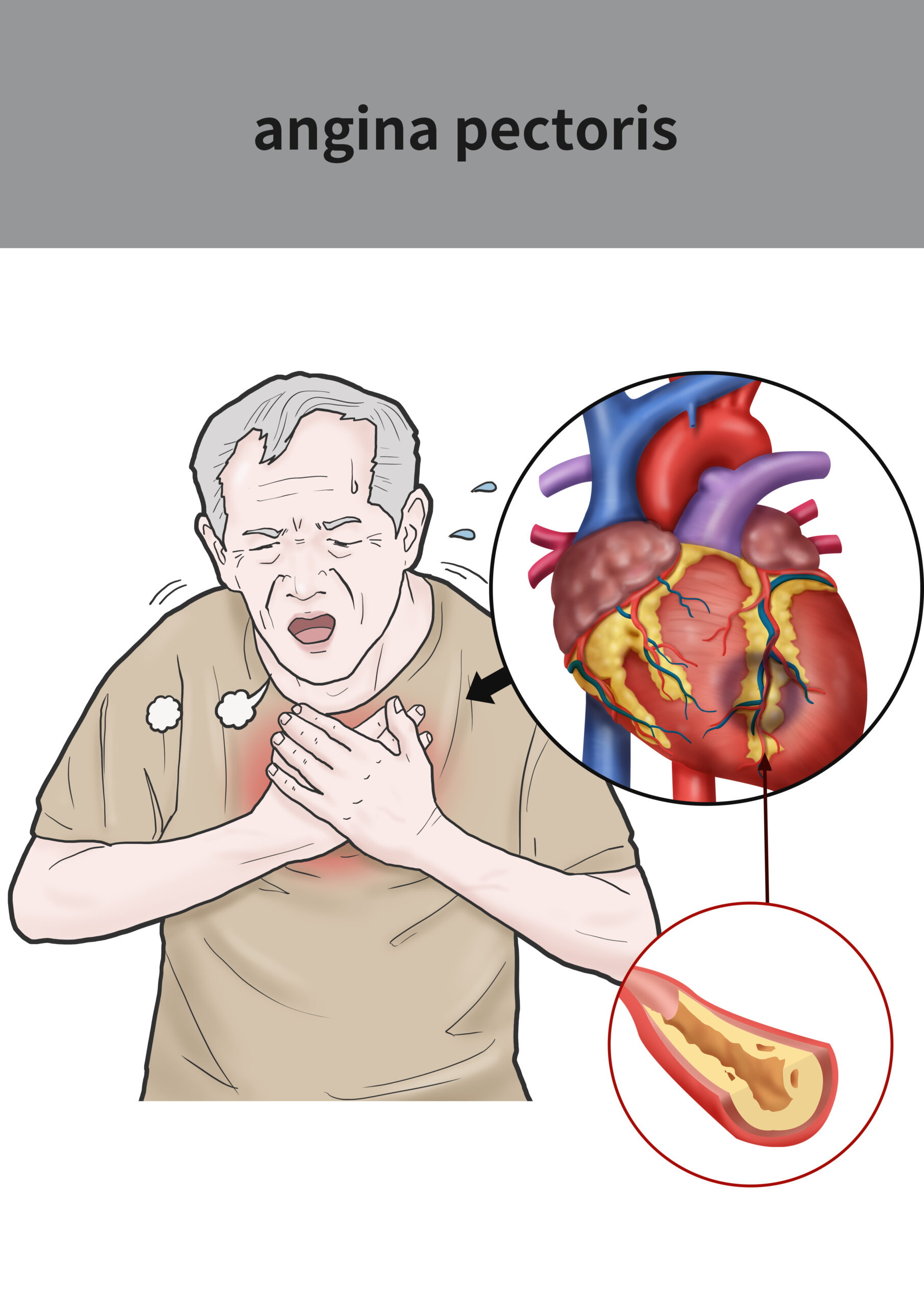Angina pectoris is a term for symptoms occurring in the course of coronary artery disease. The main symptom is chest pain. It occurs when too little blood reaches the heart muscle cells.
Angina pectoris is not a separate disease but rather a manifestation of ischemic heart disease. The heart muscle is supplied with blood by the coronary arteries. Blood provides the heart with the necessary energy, substances, and oxygen. In healthy people, the heart has a certain reserve, which means that in the event of increased exercise, the heart may receive up to several times more blood than at rest. Coronary heart disease most often develops due to atherosclerosis. It causes the narrowing of the coronary arteries, thus impeding blood flow. Lack of coronary reserve causes angina pain during stress or increased exercise.
There are stable and unstable angina pectoris. Stable angina should subside within a few minutes of stopping exercise or taking a drug that causes vessels to dilute. Stable angina usually requires drug treatment and lifestyle modifications. In this case, invasive therapy is often not necessary.
However, unstable angina is one of the acute coronary syndromes. It happens when the symptoms do not subside after resting or after taking a vessel-diluting drug. It may progress to a heart attack and require urgent treatment.

There are three main types of angina:
When it comes to angina pectoris and a heart attack, there's a key difference you need to know. Angina is when the heart muscle cells haven't died yet, while a heart attack involves the death of heart cells that didn’t get enough oxygen. If you're experiencing angina pain that doesn't go away after resting for a few minutes, it's crucial to call for medical help or see a doctor immediately. This could be a sign of a heart attack.
The heart is responsible for blood circulation and the entire body's functioning. The heart has arteries supplying blood rich in oxygen and nutrients called coronary arteries. The flow in the coronary vessels must be adequate to the demand of the heart muscle, and therefore, in states of physical exercise or stress, it should be increased. Under normal conditions, many mechanisms regulate coronary flow, including dilation of the lumen of blood vessels.
In the event of the narrowing of blood vessels, there is a reduction in the circumference of the arteries and their impaired response to substances and factors that dilate the lumen. Usually, a narrowing of more than 50% diameter![]() causes cardiac ischemia to be so significant during stress that an attack of angina pectoris occurs.
causes cardiac ischemia to be so significant during stress that an attack of angina pectoris occurs.
In most cases, the narrowing of the coronary arteries is caused by atherosclerosis. In this case, the cause of the narrowing of the lumen of the arteries is the atherosclerotic plaque growing on their walls, which consists mainly of cholesterol. The development of atherosclerosis depends on many factors, both those that you can influence (poor diet, lack of physical activity, smoking, diabetes) and those that you cannot control (age, gender, genetic factors).
Less common factors that impair coronary circulation and may cause angina pectoris include:
Your chances of developing angina pectoris may be higher due to your age, diseases, genetic factors, occupation, and lifestyle habits.
One of the most important risk factors is atherosclerosis, a condition in which the inner layer of blood vessels is damaged, and fat and cholesterol deposits accumulate on the vessel walls. Over time, these deposits can reduce blood flow, leading to angina pectoris.
Other risk factors are cardiovascular diseases, such as hypertension or atrial fibrillation. People with diabetes, obesity, high cholesterol, and anemia are also at greater risk of developing Angina pectoris.
Angina pectoris is a problem that primarily affects mature people and those who live sedentary lifestyles. If your occupation involves high-stress levels, prolonged sitting time, or makes you lose your sleep time, it also raises your chances of getting ill.
The risk of getting coronary artery disease and its symptom – angina pectoris, starts to rise in men after the age of 45![]() and in women after the age of 55. The difference is related to menopause – in women before menopause, high levels of estrogen have a protective effect on the heart
and in women after the age of 55. The difference is related to menopause – in women before menopause, high levels of estrogen have a protective effect on the heart![]() .
.
Lifestyle habits that may increase the risk of angina pectoris![]() include:
include:
Coronary heart disease frequently runs in families. If your parents or grandparents have coronary artery disease, there is a greater chance that you may also develop angina pectoris.
A characteristic symptom of angina pectoris is pain in the chest. It is diffuse – the patient cannot point out one painful point. The pain is most often located behind the sternum. It may also radiate to the arms, neck, or jaw![]() . The pain is triggered by physical excursion and stress and typically disappears after a few minutes of rest.
. The pain is triggered by physical excursion and stress and typically disappears after a few minutes of rest.
The symptoms of angina pectoris do not always have to be consistent with its typical picture. For some people, there may be little or no pain at all.
Besides chest pain, the symptoms of angina may include:
Typical symptoms are more common in men, while women usually experience non-specific symptoms. Also, in women, angina pectoris more often occurs under the influence of strong emotions.

Angina pectoris may look different in women than in men. Typical angina pain is dull, tight, or severe. In women, however, it may be felt as a sharp, stabbing pain, or women often experience little or no pain at all.
However, additional symptoms![]() appear more often in women than in men. These symptoms include nausea, vomiting, abdominal discomfort, neck pain, and shortness of breath. These symptoms are often not recognized as angina, which results in reduced and delayed diagnosis and treatment of this condition in women.
appear more often in women than in men. These symptoms include nausea, vomiting, abdominal discomfort, neck pain, and shortness of breath. These symptoms are often not recognized as angina, which results in reduced and delayed diagnosis and treatment of this condition in women.
The doctor suspects angina based on characteristic symptoms, especially typical chest pain, and a physical examination.
When angina pectoris is suspected, laboratory tests allow the doctor to determine, among others:
The electrocardiogram (ECG) reveals signs of heart ischemia. This test is performed at rest and as a so-called electrocardiographic stress test![]() . In cases where the first result is correct, only the examination during physical exercise, e.g., on a treadmill, reveals the existence of pathology.
. In cases where the first result is correct, only the examination during physical exercise, e.g., on a treadmill, reveals the existence of pathology.
Echocardiography examines the structures and movements of the heart using an appropriate ultrasound machine. An echocardiogram may be performed to assess the heart valve's structure and function, measure the heart chambers' size and function, and determine how well the heart can pump blood to the rest of the body.
Coronary angiography is usually not intended to diagnose angina pectoris but to confirm it and precisely assess the degree of coronary artery occlusion![]() . After excluding possible contraindications, the patient receives several contrast agent injections through a catheter placed most often in the upper leg artery. Multiple X-rays are taken simultaneously, allowing doctors to obtain a detailed image of the heart arteries, assess any narrowing, and qualify the patient for surgical treatment.
. After excluding possible contraindications, the patient receives several contrast agent injections through a catheter placed most often in the upper leg artery. Multiple X-rays are taken simultaneously, allowing doctors to obtain a detailed image of the heart arteries, assess any narrowing, and qualify the patient for surgical treatment.
Lifestyle modification is an essential element of treating ischemic heart disease. To prevent angina pectoris, a well-balanced diet with reduced animal fats and simple carbs should be introduced. The beneficial effect of consuming foods rich in unsaturated fatty acids![]() and vitamin D has been proven.
and vitamin D has been proven.
If you are overweight, you should reduce your body weight to normal. Regular exercises for at least 30 minutes a day are also recommended.
Treatment of angina pectoris aims to reduce the frequency of attacks, improve quality of life, and reduce the risk of death from cardiac causes.
Anyone diagnosed with coronary heart disease should take medications![]() to prevent heart attack and stroke. These are:
to prevent heart attack and stroke. These are:
People with stable angina are usually given a vasodilator by their doctor. This medicine is used to treat an angina attack. It relaxes the coronary vessels and relieves angina symptoms. This medicine is given as a tablet that dissolves under the tongue or as a spray.
Medications also help the heart work efficiently to prevent angina attacks. For this purpose, the following are used:

If medications can’t manage angina, surgery might be recommended. The surgeries performed for angina pectoris include:
To minimize the risk of acquiring conditions such as coronary artery disease and angina, there are numerous actions you can take to prevent these conditions. Below are a few recommendations to consider:
If you experience the symptoms of angina and have never been diagnosed with angina before, you should stop what you are doing and take a few minutes rest![]() . If the symptoms stop after a few minutes, make an urgent appointment with your GP. If the symptoms persist after a few minutes of rest, call an ambulance, as it may indicate a heart attack.
. If the symptoms stop after a few minutes, make an urgent appointment with your GP. If the symptoms persist after a few minutes of rest, call an ambulance, as it may indicate a heart attack.
If you experience symptoms of angina and you have been diagnosed with it already, you should take a few minutes to rest and take the medicines you were prescribed in the case of an angina attack. If the medication doesn’t help after 5 minutes, take another dose, and call an ambulance if the second dose doesn’t help.